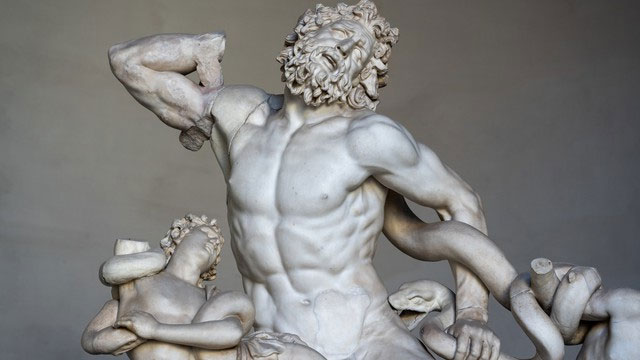Why do ancient Greek statues often have modestly small penises?
In the Vatican Museums in Rome there is on display one of the most classic sculptures of all time. That is the statue of Laocoön and his sons.
The approximately 2,000-year-old sculpture is more than two meters high and depicts the Trojan priest Laocoön and his sons. According to the Iliad and the Odyssey, Laocoön was the one who suspected the Greeks' "wooden horse" plot and advised the Trojans not to bring the horse into the city.
This was actually a plan by the Olympians to help the Greeks win. And because Laocoön wanted to interfere with the gods' plans, he and his children were killed by water snakes.

Close-up image of the statue of Laocoön and his sons at the Vatican Museums, Rome.
The statue's background story is fascinating, but there is one detail that attracts even more attention from museum visitors. This detail is located in Laocoön's extremely small "precious penis".
More worth mentioning in the Vatican museum, Laocoön is not the only statue that possesses such a small "precious" penis. Throughout the museum there are other statues depicting muscular men with tiny genitals.
The Greeks have a negative opinion of large "precious" penises
Why did ancient sculptors often give men a penis of such modest size? Surely this size is not based on the real-life size of the Greeks' penis.
According to archaeological and cultural studies, for the ancient Greeks and Romans, large genitals were considered ugly. The image of a large penis is often associated with animals such as horses and cows. goats, etc. If a person is described as having a large penis , he is often seen as barbaric, rude, dissolute and prone to indiscriminate pleasure.

In Greek mythology there is Dionysus, the god of wine and pleasure. He is often surrounded by Satyrs, short creatures that are half-human, half-goat (or horse), always naked and depicted as animalistic and hideous. They held debauched parties and entertained with the fairies living in the forest.
These forest gods and spirits are very erotic and their genitals are depicted as quite large. Dionysus's son was Priapos, who was abandoned by his mother in the mountains due to his unusually large penis . There, shepherds found Priapos, raised him, and venerated him as a fertility god. However, the general opinion of the ancient Greeks is still not very sympathetic to large "precious" penises.
Small "precious penises" represent clear intelligence and control over temper
Sculptors deliberately sculpted male statues with small genitals, which also had a meaning to show viewers that: this man is a person with rational knowledge, because of that, he We have the ability to control our desires.
Men who have self-control and know how to control themselves will always be appreciated more. They are completely different from barbarians, self-indulgent and lustful people. This is simply a trend of expressing and depicting characters of ancient Greek sculptors.

Michelangelo's statue of David is on display at the Galleria dell' Accademia.
The small penis is the ideal model of beauty from the Greek perspective . Later, the Romans continued to inherit this concept.
Not only them, Renaissance artists such as Michelangelo or Raphael also responded and created works with character characteristics similar to those of ancient Greece. For example, Michelangelo's statue of David , created between 1501 and 1504, also had a modest penis size.
Today, society's concept of male genitals has changed . A micropenis is no longer considered a sign of intellectual excellence. For many people, a large penis is considered masculine and represents success.
According to a study published by Stanford University in California, men's penises are getting even larger today. Scientific team data reports that the size of male genitalia has increased by 24% in some regions of the world over the past 30 years. But in ancient Greece, this size would have caused aesthetic horror.
- Why are ancient Greek statues naked?
- The reason the ancient Greek statues had such a place was so miserably small
- The music was recreated from ancient Greece
- Laos continuously discovered Buddha statues believed to date back hundreds of years
- Detecting ancient phenomenon on the seabed of Cu Lao Cham
- Discovered the headless Greek king
- Decipher the unusual statues of the year 1,400 years
- The truth behind many ancient Egyptian statues lost their noses
- Discovering the Greek seabed statue helps counteract
- The mysterious magnetic field covered 10 ancient statues 2,000 years
- A place to store Greek civil treasures
- Knowing how the ancient Greeks lived
 'Fine laughs' - Scary and painful torture in ancient times
'Fine laughs' - Scary and painful torture in ancient times The sequence of numbers 142857 of the Egyptian pyramids is known as the strangest number in the world - Why?
The sequence of numbers 142857 of the Egyptian pyramids is known as the strangest number in the world - Why? History of the iron
History of the iron What is alum?
What is alum?